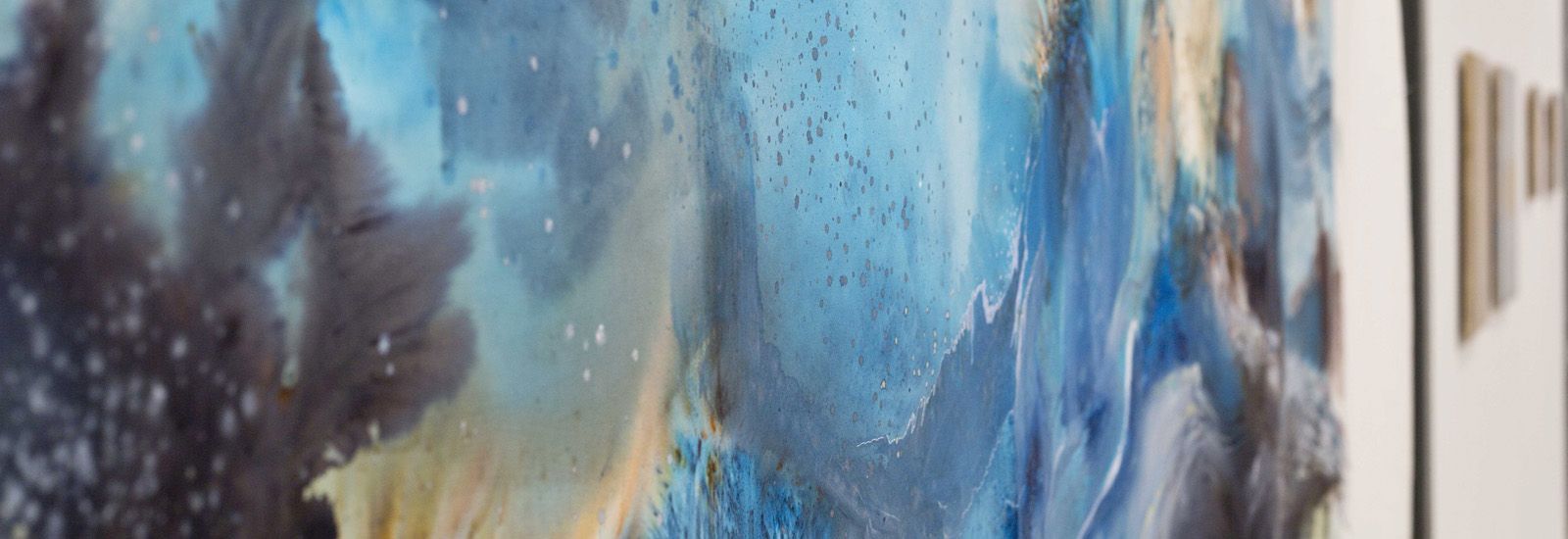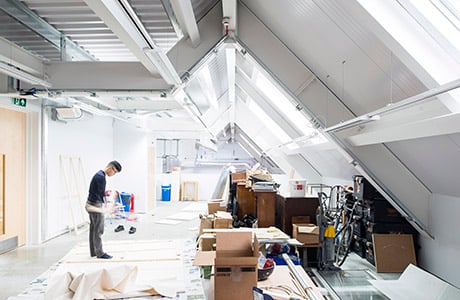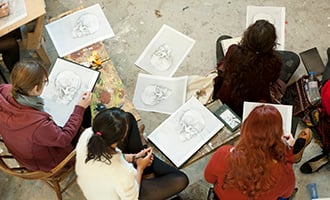Fine Arts and Visual Arts Majors for a Student Who Intends to Go to Law School
Creative person: Evie, graduated 2014 Photographer: greenroomphotography/Kinga Lubowiecka 
Fine Art
- Overview
- Structure
- Admissions Requirements
- Careers
- Fees and Funding
- Studying at Oxford
Unistats data for this form can be found at the lesser of the folio
Art is the making and report of visual art. Information technology educates and prepares students to become artists and to follow other practices that are aligned with the making of art. The curriculum is centred on the individual student'south potential and imagination.
The Ruskin School of Fine art offers a iii-year studio-based BFA course in which students work alongside each other in collaboratively-organised studios. Whereas many fine fine art courses run in an environment devoted exclusively to fine art and blueprint, Ruskin students, as members of a collegiate university, have the reward of contact with their contemporaries on all of Oxford's other courses.
The Ruskin course aims to develop strong independent points of view and a mature grasp of the range of critical debate surrounding contemporary art and its many international histories. Oxford's short terms, coupled with the ambitious atmosphere at the Ruskin, suit highly-motivated and resourceful students with a good sense of how to organise their fourth dimension both in and out of Oxford.
The offset year of the course is structured to innovate students to one another, to the resource of the schoolhouse and to the staff involved in teaching and running the Ruskin. Students volition familiarise themselves with their fellow students' work, have part in group criticism and engage in intensive dialogue with tutors and visiting artists.
The intimate working surroundings of the school, arranged in two buildings, allows fine art history, theory and criticism to be treated every bit integral to the evolution of studio piece of work. The Ruskin likewise enjoys a potent and constructive relationship with Modern Fine art Oxford (an heady and influential contemporary art space) and students take full access to the many infrequent University libraries and museums, including the Ashmolean and the Sackler Library.
 | "Unlike ... other art courses in the Great britain, the Ruskin does non require you to specialise in any particular medium. [And] the interesting blend of academic and practical that this course offers was perfect for me." "My time at the Ruskin was extremely positive... The majority of the course is structured with independent do, but the studio surroundings means there are always people around to bounce ideas off... The sense of customs and back up at Ruskin is what makes it stand up out, and the course will aid nurture your practise in a caring and challenging mode." |
A typical week
Well-nigh students' weeks will typically consist of several, or all, of the following: a 1-to-i studio-based tutorial focusing on the individual student's art work, a group critique of pupil art piece of work, a skills-based workshop, a history and theory lecture and seminar, and a talk by a visiting speaker. You will spend much of your time working in your own studio spaces, where you will be supported by specialists in the art-making techniques available at the Ruskin.
Tutorials are commonly 1:1 with a tutor. Typically there are 10-xx students in a grouping critique (in which 4 students nowadays their work, and give-and-take is guided by two tutors). At that place are usually no more than than 12 students in whatsoever workshop or seminar and around 30-40 for lectures and visiting speakers' talks. Most teaching is delivered by staff who are dedicated tutors in their discipline. Many are leading artists and writers with years of experience in teaching and research. Some teaching may be delivered by postgraduate students who are studying at doctorate level.
To find out more nigh how our teaching year is structured, visit our Academic Year folio.
Course structure
| Year 1 | |
| COURSES Students develop their studio piece of work in give-and-take with the school'southward kinesthesia, tutors and visiting staff. They are allocated a tutor at the kickoff, who monitors progress, sets targets and directs them in their studies. Work is regularly presented and discussed at group critiques involving staff and students from beyond the school. Alongside this, workshops and projects designed to innovate a range of techniques and approaches are offered throughout the year. In addition, students attend taught practical classes in man anatomy besides equally lectures, seminars and tutorials in the history and theory of visual civilization. Experimentation is highly encouraged. | Cess Practical studio-based work, including human being anatomy; three submitted essays in the history and theory of visual culture |
| YEARS 2 AND three | |
| COURSES Years 2 and three are similar in structure (with the exception of Beefcake), and go on the tutorial arrangement introduced in the first twelvemonth All students are required to go on the written report of art history and theory and to submit three essays during the course of the 2d yr. In the beginning term of the tertiary year, Finalists concord with their tutor on the title and bailiwick of an extended essay. This six,000-word essay is submitted at the end of the second term of the tertiary year every bit function of the Final Test. Students are expected to establish a stiff bond between the interests of the essay and their studio studies. | ASSESSMENT(Twelvemonth two) Submission of three history and theory essays, which are assessed every bit part of the Concluding Examination Cess(Twelvemonth three) An extended essay; a portfolio of piece of work made during the second and third years and an accompanying exhibition |
Visit the Fine Art website for more information.
Bookish requirements
| A-levels: | AAA (or AAB for candidates who have undertaken or completed a postal service-18 Art Foundation form*) |
| Advanced Highers: | AA/AAB |
| IB: | 38 (including cadre points) with 666 at HL |
| Applied General Qualifications: | BTEC and Cambridge Technical Extended Diplomas: DDD UAL Applied Full general Extended Diploma (2018-): HM (High Merit) (Every bit the Fine Art degree also includes a substantial history and theory component, applicants with vocational qualifications will need to demonstrate that they take the critical, inquiry and essay-writing skills required for academic study at Oxford.) |
| Or whatever other equivalent (meet other Great britain qualifications, and international qualifications) | |
* Post A-level applicants with AAB at A-level (or equivalent) will exist expected to submit an outstanding portfolio and to achieve at least a Merit or equivalent on their Foundation course.
If applicants are studying for the UAL Level 3 Applied General Extended Diploma in Fine art and Design they would be expected to accomplish a High Merit. As the Fine Art degree also includes a substantial history and theory component, such applicants will exist expected to accept successfully completed a range of modules that include fine art history.
Wherever possible, your grades are considered in the context in which they accept been achieved. (Run into further information on how nosotros utilize contextual data.)
Subject requirements
| Recommended: | The Ruskin recommends that candidates have studied Art at A-level or equivalent qualification. Information technology is highly recommended that candidates have undertaken a post-xviii Art Foundation course before applying. |
Applying
All candidates must follow the application procedure equally shown in applying to Oxford. The information below gives specific details for students applying for this class.
Portfolio submission
| Description: | Portfolios must be submitted digitally, via an online platform chosen SlideRoom , which will exist made available on the Ruskin website soon after the awarding deadline; candidates who have submitted a UCAS application to study for the BFA programme will be emailed the link to SlideRoom. At that place is no prescription for the content of a portfolio: candidates should aim to include a range of work which gives a sense of their creative and intellectual interests and an awareness of contemporary art. You will be able to upload your portfolio with videos, photographs, audio files and PDFs. Please see the Ruskin website for further information.* |
| Submission deadline: | 6pm, Thursday 3 November 2022 |
*Read more about the portfolio
Interview and applied exam
TBC for applicants applying for entry in 2023.
What are tutors looking for?
All applicants are required to submit a portfolio of their fine art work. Tutors are looking for work that goes beyond the mere fulfilment of schoolhouse curricula. Tutors will seek bear witness of a breadth of date, a sense of purpose and an emerging artistic voice in the way the portfolio is edited. If y'all are shortlisted you will be asked to nowadays a small-scale number of boosted recent pieces of your work to discuss during interview.
For more detail on the selection criteria for this class, delight see the Ruskin School of Fine art website.
Careers
Afterwards graduation, virtually students go on to work in the arts sector, equally practising artists, teachers, curators and art writers, fabricators and technicians, in public and private museums and galleries, community arts organisations and for civilisation and heritage councils and institutions. Many also pursue careers in academia, architecture, and the film and digital media industries.
Many Ruskin graduates have won or been shortlisted for prestigious awards and prizes across many media. In 2019, Nazia Khan (BFA 1990) represented Islamic republic of pakistan at the Venice Biennale, and Nathaniel Mellors (BFA 1999) represented Finland there in 2017. In 2016, Helen Marten (BFA 2008) won the Turner Prize and the Hepworth Prize for Sculpture, and Elizabeth Price (BFA 1988) won the Turner Prize in 2012. Paul Franklin (BFA 1989) was awarded the Oscar for Visual Effects for his piece of work on the science fiction flick Interstellar in 2015. Conrad Shawcross (BFA 1999) won the Jack Goldhill Award for Sculpture in 2014.
Ruskin Alumni were included among the Bloomberg New Contemporaries in 2017, 2016, 2015 and 2014 including Lucy Mayes, Ruth Spencer Jolly, Melanie Eckersley and Emily Motto. Nathaniel Whitfield (2016/17) was selected to take part in the Whitney Independent Studies Program in New York. The works of Khushna Sulaman-Butt and Alvin Ong were included in the BP Portrait Award at the National Portrait Gallery, London in 2018.
Fees
Additional Fees and Charges Information for Fine Art
In the showtime year of the BFA class, students are provided with bones materials and more specialist materials are available to buy at toll. There is no expectation for students to make it with whatever additional equipment or materials beyond those they may already possess.
Each student receives a materials grant (currently £475) from the Ruskin School of Art for each yr of the course. Finalists also receive a further materials grant (£280) for their work in the terminal prove. Students in the second and third years of the form are expected to run across any additional costs for materials, applying to their college for support in the outset instance. Colleges may too provide back up for pupil projects and travel, including the optional work experience programme for second year students who have part in the Ruskin'due south Professional Do Programme.
Throughout the class, students are able to borrow an all-encompassing choice of equipment on a sign-upward basis. In the commencement calendar week of their first term, all students pay an equipment deposit of £100. The deposit system is to secure confronting the borrowing of departmental equipment (and library books) and the deposit is returned to the student at the end of the course.
Concluding year students normally stage a public exhibition of their work following the final examination and they collectively raise funds for this through sponsorship, fine art sales and other activities.
Top-rated art schoolhouse in the UK
The Complete University Guide placed the Ruskin as the leading fine art school in the UK in 2020, 2019, 2017, 2016 and 2015.
Feel inspired?
If you'd like to read effectually the field of study, the post-obit are a expert place to start: Julieta Aranda ed., What is Contemporary Art; Roland Barthes, Camera Lucida: Reflections on Photography; Hito Steyerl, The Wretched of the Screen; Julian Stallabrass, Contemporary Fine art: A Very Brusque Introduction and Audre Lorde, The Master's Tools Will Never Dismantle the Chief's Firm.
You might similar to wait at some online resources, such as ArtForum or the repository of moving epitome and sound art, UBU Web. There are as well lots of fascinating journals, including east-flux, Frieze and ArtRabbit. We recommend prospective students attend exhibitions and await at art works as much as possible. Public art galleries like Tate Mod, Whitechapel, and the Serpentine in London, the Ikon in Birmingham, the Liverpool Tate, the Whitworth in Manchester, the Baltic in Gateshead, the Arnolfini in Bristol and Tramway in Glasgow are all excellent places to see contemporary art. The Tate Modern website also has links to articles and videos on contemporary art and artists.
Source: https://www.ox.ac.uk/admissions/undergraduate/courses/course-listing/fine-art
